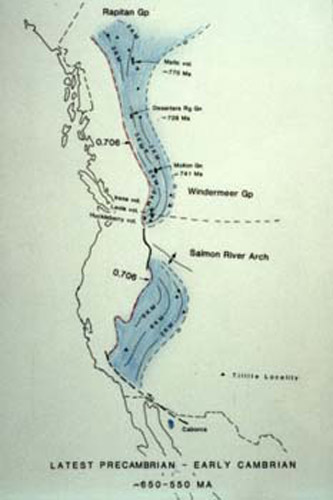lec2photo7.jpg
This map depicts the latest Precambrian and the earliest Cambrian time. The sediments that you see with contoured thickness, thickening to the west are the first sediments deposited on the newly established rifted margin. This is also referred to as a “Passive Margin” as there is no active tectonic deformation driven by interactions between plates. In the passive margin setting, the only deformation is extensional and is a consequence of sediment-loading causing subsidence of the warm and weak western edge of the continent. We know roughly when the rifting happened because the first sediments (localities denoted with triangles) deposited onto the passive margin are sediment from the extensive late Precambrian glaciation. We will discuss these particular deposits in detail after a few more slides. The deposits on the passive margin thicken to the west, and are largely non-marine and nearshore clastic sediments, reaching thicknesses of up to 8 km! This great thickness reveals a couple of important things. First the sedimentation rates were extremely high and there was a great deal of sediment available from the continent to the east to be deposited on the new passive margin edge. But not only was there a high sedimentation rate, but the depositional environments were relatively consistent through time at a locality. This suggests that even though there was a good deal of sediment moving off the continent, the thinned basement rocks off the edge of the continent were subsiding rapidly, keeping the depositional interface at roughly the same elevation (thus the consistent depositional environment). It is the extensional rifting and the warm weak crust that allow for rapid subsidence following rifting. So as the continent is becoming loaded and thinned through extensional destruction of the continental edge, the continents are undergoing a constructional period as the sediment is accumulated on the margin. An interesting thing about this passive margin is that we can’t see a section continuous across strike leading to the distal, extreme western edge of the margin. Image courtesy of Professor Burchfiel.












